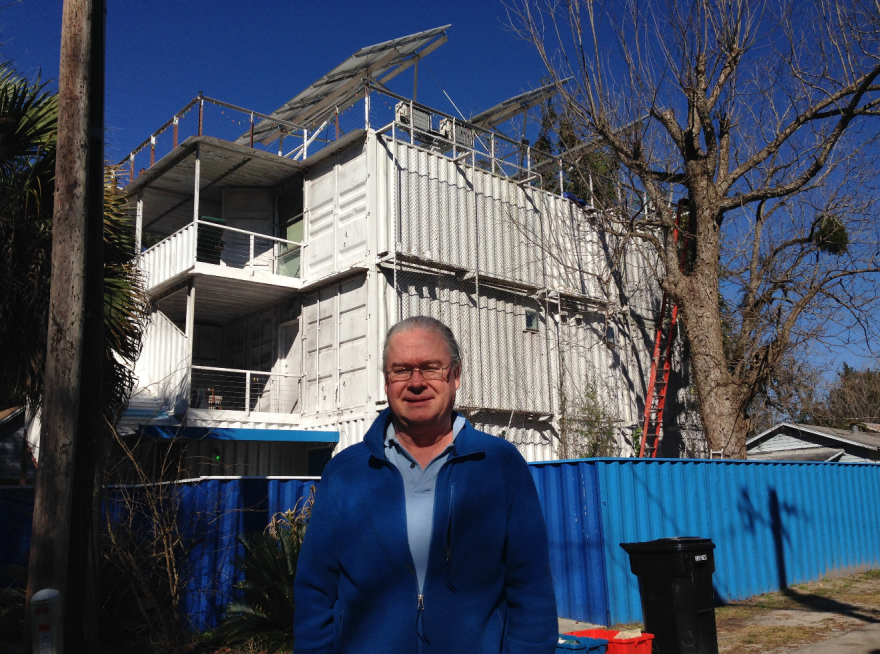In the Porters neighborhood near downtown Gainesville, most residents live in one-story homes made of wood painted gray, brown or pale green and with enough space left for a small yard.
Tom Fox’s home at 612 SW Fifth Terrace stands above his neighborhood’s skyline, literally and figuratively.
Fox, 51, said he takes pride in knowing his three-story, nearly 3,600 square-foot house is one of the first houses in Florida made entirely of old shipping containers.
Fox said he’s always wanted to build his own house - one that was affordable, strong and energy efficient.
Three years into living in this home, Fox said he’s glad he chose to build it with material strong enough to handle hurricane winds, salt water and 60,000 pounds of weight.
“That’s the thing,” he said. “This house will probably be here 300 years from now, with some minor maintenance.”
Fox found inspiration for his project while on a trip visiting his brother in London 20 years ago. He visited Container City, an area filled with offices and apartments constructed out of shipping containers. On a later trip to Amsterdam, he saw college students living in fully functioning, comfortable container dorms.
“On the outside, you could tell they were shipping containers, but on the inside, you couldn’t tell at all,” he said.
Building a new home with shipping containers didn’t require a lot of deliberation for Fox. He and his building project team picked 12 unused shipping containers sitting in a shipping yard in Jacksonville and began the nine-month-long process to build his home.
Fox spent about $240,000 to make his place exactly the way he wants. He spent $200,000 on the structure itself and $40,000 on 36 solar panels, which provide his own house and his neighborhood with energy as part of an energy tariff program with Gainesville Regional Utilities that pays him 20 cents per kilowatt-hour.
Fox’s home, pairing sustainability with affordability, is LEED platinum certified. Leadership in Energy and Environmental Design, or LEED, is a classification of buildings developed by the U.S. Green Building Council that recognizes the highest level of construction that minimizes environmental impact.
Fox involved LEED in the construction from the beginning. The LEED workers oversaw the construction process, ensuring Fox's home passed all the qualifying checkpoints, including using wood that was grown within 100 miles. Once the construction was finished, LEED workers conducted a pressure test to ensure there were no leaks in the heating or cooling systems. Fox said he spent an additional $3,000 for the LEED workers' time and labor hours.
Stephen Bender, a Gainesville architect and adjunct professor of architecture at the University of Florida, was one of the key players in helping Fox realize his vision for a modern, alternative home.
Bender, who has known Fox for nearly 20 years, said he knew his client would fully commit to building a modular home, or a sectioned home made from already built pieces like shipping containers.
He said the trick was getting the pieces to fit together perfectly.
“You end up cutting the container to make larger spaces,” Bender said, “but when you’re using the shipping containers, you have to reinforce the openings.”
After helping Fox finish his home, Bender said more than a dozen local residents approached him and expressed their interest in starting similar projects.
Bender attributes this new interest in alternative housing to the national economy’s resurgence after the housing downturn in 2008.
He also said this interest has yet to appeal to most potential homebuyers.
“I think if you want a shipping container residence,” he said, “then you’re one of only a few.”
Roughly 15 percent of homebuyers on a national level are willing to move into alternative housing, Bender said.
Eric Gonzalez, president of the Builders Association of North Central Florida, said he hasn’t seen a growing trend in alternative home projects like Fox’s shipping container home.
Gonzalez, who has been building custom homes in Gainesville for more than 20 years, said he has seen the demand for energy efficient homes increase over the last seven to eight years, but the push for more alternative homes won’t come anytime in the near future.
“Certainly, there’s always people that have an idea and want to do something regardless of the cost or any other factors,” Gonzalez said.
“But, I don’t see Alachua County becoming a place, in the next couple of years, where any of the alternative types of homes will be built in the masses.”
Sherry Ahrentzen, a research professor with UF’s Shimberg Center for Housing Studies, said part of the issue with raising awareness for shipping container housing is paying the transportation fees to have the containers brought to a specific site.
Ahrentzen said another issue that may turn off potential homebuyers is the visual aspect of seeing a bare shipping container as a home. She said one thing she would tell interested buyers is that some building factories can create facades described on this website - to give a container’s outside a bricklayer look or a log cabin exterior.
“With the manufacturing technology we have today, you wouldn’t even know that the outside was prefabricated," she said. "So that’s why you can see fancier homes or structures with an outside siding, but the core is still a shipping container.”
Fox knows he spent a lot of money, but said he’d recommend others interested in building shipping container homes to keep it simple because the end result will give them a solid, stable home.
He said he plans to host an open house in late March so that local residents or visitors from far away can ask him questions and learn more about different types of alternative homes.
“You don’t have to do what I did,” Fox said, “but you can take one shipping container and someone who maybe does want an alternative lifestyle can live comfortable and conscious of their effect on the environment.”



